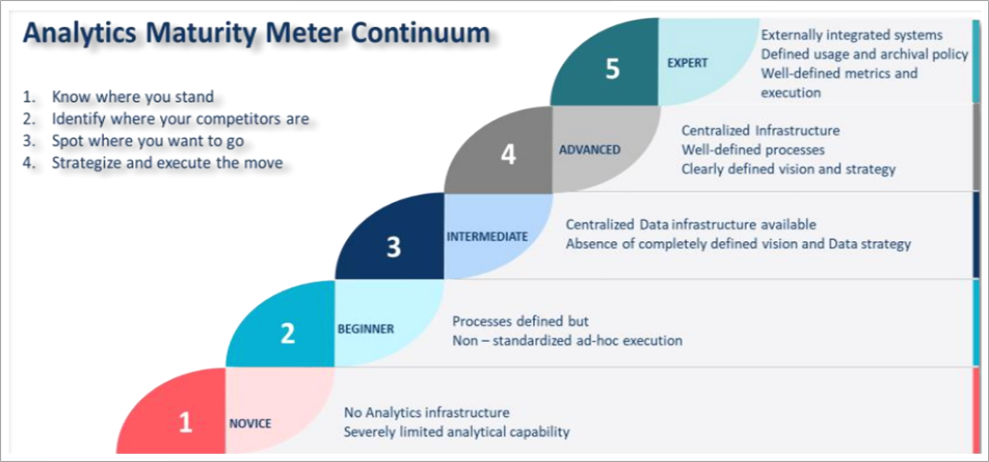AWS Partner Network (APN) Blog
Enabling Machine Learning Adoption with Genpact’s Analytics Maturity Meter and AWS
By Subrahmanyam Madduru, Global Partner Solutions Architect – AWS
By Sreekanth Menon, AI/ML Global Practice Leader – Genpact
By Megha Sinha, AI/ML Practice Leader – Genpact
 |
| Genpact |
 |
Companies of all sizes are making significant investments in machine learning (ML) initiatives. Yet, 70% of organizations do not reap the desired return on investment (ROI). Gartner states that 85% of ML projects fail to deliver, and only 53% of prototypes make it to production.
This underscores the need for a solution that can help organizations understand their position in their ML adoption journey—beginning with advancing their analytics maturity.
Organizations realize the value of data and analytics for their businesses, but not all of them have been successful in defining a mature analytics vision and strategy. A strong data and analytics roadmap is crucial but is often neglected.
By cross-leveraging experience in process management, safeguarding data, and rich analytics practices, Genpact has developed an analytics maturity assessment framework known as the Analytics Maturity Meter (AMM).
To provide the insights required for developing an effective strategy, AMM assesses an organization’s analytics maturity quotient (AMQ) by evaluating its current capabilities in data, process, technology, talent, and enterprise leadership.
In this post, we discuss how AMM helps organizations assess their current state of analytics maturity and devise a roadmap to advance it with Amazon Web Services (AWS) so they can ultimately adopt machine learning at scale successfully.
Genpact is an AWS Advanced Tier Services Partner with a core strength in domain-driven expertise running digital transformation for global Fortune 500 companies across the industry spectrum. It is also a part of the AWS Well-Architected Partner Program.
Why Measure Analytics Maturity for ML Adoption?
There is no picture-perfect end state for analytical maturity. Data and analytics maturity must be viewed on a continuum, and the future state operating model must be adaptable to stay ahead of the competition, recognize disruptive models, and lead in a digital age.
AMM enables organizations to identify key areas to address in order to advance in their analytical maturity journey. For example, a global medical equipment manufacturing company wanted to create contextual tailor-made customer experience (CX) campaigns leveraging online and offline data.
In order to set up a scalable operating model and build a predictive CX platform, the customer required an in-depth assessment of the current state and a roadmap for future state advanced data and analytics capabilities.
Genpact’s AMM identified and assessed process maturity, people maturity, technology maturity, data maturity, and enterprise strategic maturity. This enabled the client to benchmark their current state and identify capabilities recommended for an advanced analytics transformation initiative, doubling the speed of implementation.
How Analytics Maturity Impacts ML Adoption
Measuring analytics maturity influences three critical factors of ML adoption at scale:
Factor #1: Realizing the Business Value of Analytics
Identifying viable analytics use cases and establishing appropriate scalable analytics infrastructure remains a challenge for organizations. The following areas need to be addressed to ensure the organizational goals:
- Identify if the outcomes of your analytics initiatives are lagging or innovating.
- Understand analytics resource utilization to effectively turn data into actionable insights.
- Establish and improve data governance practices.
- Benchmark the alignment of analytics outcomes to business goals.
- Proliferate enterprise-wide data literacy.
Factor #2: Establishing the Right Analytics Foundation
All digital transformation initiatives require the right tools, platforms, and infrastructure to manage and process the data. Here are a few areas to look into to set up the analytics foundation:
- Identify, assess, and strategize investment into the right data platform for the organization.
- Collaborate and build the data architecture with the best choice of technological products and platforms.
- Create a business-centric, industry-focused data fabric for functions within the organization alongside robust master data management.
Factor #3: Converting Data into Actionable Insights or Data Products
The ultimate goal of storing and managing data is to gather actionable insights that can be used for effective decision making.
Data wrangling from different sources—internal and external—into a consistent and compatible format is the most time-consuming portion of the process.
In order to address these needs, organizations must look into the following areas when building such platforms:
- Establish organizational analytics strategy.
- Invest in talent, process, and change management for advanced analytics capabilities.
- Establish and improve human-augmented, embedded artificial intelligence (AI).
- Identify and create customer-centric data products for a faster sense of the market.
- Measure and track value from data and analytics initiatives.
Benefits of Genpact’s Approach
Modern analytics requires more than just data. It requires a data-first culture, processes conducive to capturing data, technological prowess to store and process data, and strong buy-in from leaders to drive the transformation top-down.
In support of building that data-first culture, Genpact’s AMM delivers the following key benefits:
- Easy-to-use interface: The AMM web application provides an easy-to-navigate interface for multiple stakeholders to launch, respond to, and record an assessment.
- Comprehensive assessment: AMM measures maturity on all dimensions as part of one assessment, and provides an aggregated score of the maturity level on a defined scale between 1-5.
- Clear and specific feedback: Outputs are mapped on a 5×3 matrix, clearly identifying strengths, risks, and areas for improvement. Please refer to Figure 3 below to see a sample of feedback matrix.
Genpact makes a world of difference for customers building robust, scalable analytics pipelines, which further accelerates their ML adoption trajectory. In addition, AWS also provides business leaders with optimized, sustainable data and analytics capabilities.
This requires a framework that’s contextually designed to enable democratized access to data, analytical services, and actionable insights utilizing a broad and deep collection of purpose-built data services with security, compliance, scalability, and agility designed into the system.
To help organizations build robust analytics pipelines with these characteristics, Genpact has developed a scalable data analytics reference architecture which we will discuss in detail in the following section.
How Genpact Assessments Work
The AMM evaluates an organization’s maturity in the following areas:
- Data: Storage and capability, quality, and governance and compliance.
- Process: Definition and design, implementation, and metrics and governance.
- Technology: Architecture, risk and security, and governance.
- Talent: Skills and sourcing strategy, organization structure, and engagement and progression.
- Enterprise and leadership: Business priorities, culture and change, and sponsorship and funding.
Figure 1 describes 15 maturity factors spread across five key dimensions that enable organizations to measure end-to-end analytics maturity.
Figure 1 – Genpact Analytics Maturity Meter (AMM).
During a Genpact assessment, as illustrated in the pie chart above, AMM assesses data maturity, process maturity, technology maturity, talent maturity, and enterprise and leadership maturity.
Each of the five dimensions is scored on a scale of 1-5, with 1 representing the lowest maturity and 5 being the highest. The overall score is a weighted average, taking into account the degrees of importance of the five dimensions.
Each score is further defined as follows:
- Novice: Severely limited or zero analytics infrastructure.
- Beginner: Non-standardized, ad-hoc execution.
- Intermediate: Enterprise has data infrastructure available, but lacks a well-defined data strategy.
- Advanced: Centralized infrastructure and a clearly-defined vision and strategy are in place.
- Expert: Enterprise has externally integrated systems and well-defined metrics.
Figure 2 – Definition of Genpact AMM continuum levels or scores.
AMM generates an automated consolidated assessment, clearly defining the maturity index of each pillar along with key findings of the strength components, development components, and highest- and lowest-rated questions.
The maturity meter is configurable for assessment both at the enterprise level and at the project level. Furthermore, Genpact can benchmark an organization’s score against trends in specific industry segments.
Figure 3 – Reference view of a sample current state report of AMM assessment.
With the AMM assessment complete, customers are ready to design their data and analytics strategy. They will have the needed infrastructure to implement ML solutions at scale with the target operating model comprising of reference architecture, security framework, team composition, associated RACI matrix, and playbook for sustained operations.
Scalable Data Analytics Reference Architecture on AWS
Figure 4 shows how Genpact enables organizations to establish the appropriate analytics foundation to deliver actionable insights from data.
The ingestion mechanism, data cataloging, processing, analytics, AI/ML services, and output methodologies must be custom-built based on the contextual requirements.
Figure 4 – Running a modern scalable data analytics pipeline on AWS.
Multiple data sources within the enterprise as well as third-party data are collected. These data sources may include EnterpriseDB data, file systems, mobile and edge devices, software-as-a-service (SaaS) applications, and streaming data files.
Recommended AWS Products
Various components and AWS products act as core building blocks for modern scalable data analytics pipelines.
Depending on the type of the data, AWS products such as AWS Database Migration Service (AWS DMS), AWS DataSync, Amazon Kinesis, Amazon Managed Streaming for Apache Kafka (Amazon MSK), AWS IoT Core, and Amazon AppFlow are used to ingest the data into a data lake on AWS.
Getting Started with Genpact AMM
Designing mature data analytics pipelines for machine learning at scale is a combination of strategic advisory and implementation efforts.
Customers stand to benefit from a four-week engagement with Genpact to:
- Understand their current analytics maturity.
- Benchmark their maturity against counterparts in the industry.
- Design a roadmap for leveraging AWS services to achieve advanced maturity.
- Implement pipelines in the customer’s environment.
Upon completion of the four-week engagement, a detailed assessment and consolidated analytics maturity score is made available. The report clearly delineates the strength components, development components, variations, and deviations identified in the responses of the stakeholders, and a future state roadmap to achieve the desired state.
The future state roadmap includes an architectural representation of the tech and platform that should be set up (see Figure 4).
Furthermore, a specialized, Agile product-oriented delivery (POD) can be set up to provide implementation services on AWS for an end-to-end transformative experience. An Agile POD is a team of people with diverse competencies who work in collaboration to achieve the needs of the client. These teams are self-organized and collaborative, and they focus on meeting customized, specific, and strategic goals for solving targeted business needs of the clients.
Conclusion
In this post, we described the importance of assessing the current analytics maturity of an organization or of individual functional units within an organization.
Such an assessment is critical to either bringing all of the functions to a baseline maturity level or to improve the maturity of organization against the industry benchmark. A scalable pipeline requires customization according to the specific needs of the upstream data and downstream data products.
Therefore, several components each catering to specific needs are showcased in the reference architecture to achieve a future state analytics-ready platform in the organization for implementing and adopting machine learning at scale.
If you’d like to know more about how Genpact can enable your organization in ML adoption, check out the Genpact MLOps practice.
Genpact – AWS Partner Spotlight
Genpact is an AWS Advanced Tier Services Partner with a core strength in domain-driven expertise running digital transformation for global Fortune 500 companies across the industry spectrum.




